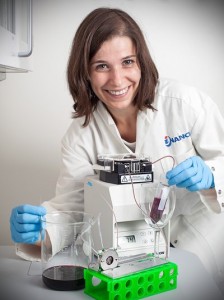
PhD student Joana Guerreiro has taken part in developing a sensor, which has been dubbed the ‘mini-mouth’.
Credit: Lars Kruse, Aarhus University
The ‘mini-mouth’ – that’s what scientists have dubbed the new nanosensor that can mimic the sensation that wine creates in a person’s mouth, which then determines how a specific alcohol tastes.
This technology was created by PhD student Joana Guerreiro from Aarhus University in Denmark, and sets out to detect the level of astringency associated with a particular wine. A wine’s astringency is characterized by the dry sensation drinkers get in their mouth when they drink wine.
This from Aarhus University:
Quite specifically, the sensor is a small plate coated with nanoscale gold particles. On this plate, the researchers simulate what happens in your mouth by first adding some of the proteins contained in your saliva. After this they add the wine. The gold particles on the plate act as nano-optics and make it possible to focus a beam of light below the diffraction limit so as to precisely measure something that is very small – right down to 20 nanometres. This makes it possible to study and follow the proteins, and to see what effect the wine has. It is thereby possible to see the extent to which the small molecules have to bind together for the clumping effect on the protein to be set off.
Read the full article here.
While the technique itself is not new, the ingenuity lies in using it to create a sensor that can measure an effect rather than just the number of molecules.
This technology seems as though it would threaten the livelihood of sommeliers, but researchers say that is not what the sensor is intended for. Instead, the team at Aarhus University hopes that this will produce a tool that is useful in wine production.
Want to see what else sensors can do? Head over to our Digital Library to see the newest cutting-edge sensor research.



